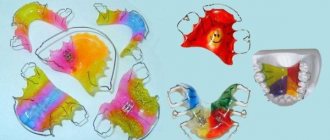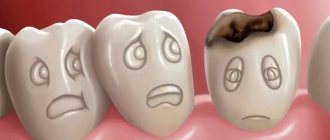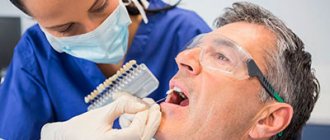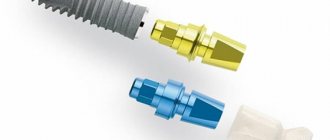A person's first teeth begin to erupt before the age of one, when milk still serves as the main food. That is why Hippocrates gave the name “milk” to non-permanent teeth, the replacement of which with permanent ones begins at 5-6 years. Considering that milk contains the main building material for teeth - calcium, it is necessary to follow a proper diet in the future. And if it is violated, there is a high probability of tooth decay in children, which will require treatment of baby teeth in order to avoid problems in the future.
Milk teeth are formed during the period of intrauterine development, at 10-12 weeks, and at 26-27 weeks the formation of incisors begins.
There are a number of differences between baby and permanent teeth:
- dairy ones have a smaller crown;
- the enamel layer is thinner, so baby teeth are more susceptible to destruction, and at the age of 5–6 years they themselves fall out;
- Before the permanent teeth begin to grow, the roots of the milk teeth begin to dissolve.
Usually, a baby’s first tooth appears around six months. Parents notice swelling of the gum, then it becomes thinner and a tooth can be seen showing through the gum. When the gums break through, the first baby tooth will appear on the surface. It is generally accepted that teeth should erupt at a certain time in accordance with the sequence, but this is quite arbitrary and in practice there are deviations in one direction or another.
The delayed appearance of the first teeth does not indicate a delay in the development of the child. This may be determined by heredity, lack of vitamins or previous infection.
At 2.5-3 years old, a child has 20 teeth: 4 upper and lower incisors, 4 canines and 8 chewing units. All of them then fall out and are replaced by permanent teeth, to which 12 more are added (with wisdom teeth). During the first year of a child’s life, it is necessary to regularly show all medical specialists to monitor his development. A dental examination is also required, which some parents ignore, considering it unimportant for the child’s health.
Dental status of children
The condition of the oral cavity directly affects the entire body:
- pathological changes can lead to malfunctions of internal organs (kidneys, gastrointestinal tract) and the appearance of diseases;
- with an incorrect bite, breathing through the nose is impaired, which leads to dysfunction of organs and organ systems;
- caries and the complications caused by it cause sore throat and other diseases, the causative agents of which are streptococci, which cause carious changes in the teeth.
The body characteristics of young children and their underdeveloped immune system determine that they are at risk for developing diseases. Since the body is a single interconnected whole, the condition of the oral cavity is given the same close attention as other organs. That is why WHO has proposed that dental examinations be carried out according to a specific schedule. If a child has a toothache, an immediate unscheduled visit to a pediatric dentist is necessary for an examination and prescription of a course of treatment.
Reasons for the development of edentia
It is difficult to name the exact causes of this pathology, because to date the disease has not been sufficiently studied. According to existing hypotheses, the first manifestations of complete or partial adentia in a child occur during the period of intrauterine development. They are associated with disturbances in the development of the ectodermal layer and the formation of organ roots. Edentia of two can also be caused by endocrine pathologies of the fetus, as well as genetic reasons.
As for secondary adentia, experts identify several variants of the clinical picture of this disease, which is diagnosed relatively often. According to statistics, tooth loss is most often caused by the following factors:
- caries;
- other advanced oral diseases, in particular periodontitis and periodontal disease. Lack of treatment leads to destruction of the masticatory organ;
- other pathologies that cause a general deterioration in the body’s condition. As a rule, they are associated with the functioning of the endocrine and immune systems;
- age-related changes that lead to deterioration in health, including tooth loss;
- hereditary factors
- mechanical injury, for example, a strong blow. In this case, the tooth may fall out either immediately if the main impact was on it, or later if the gums were damaged or the tooth remained in the jaw but was severely damaged. Mechanical trauma is one of the most common causes of adentia, including in children. In a small child, it can lead to developmental defects in baby and permanent teeth.
First examination of a newborn
Immediately after birth, the baby is examined by specialists, including a dentist. This is important because an assessment of the general condition and reflexes is necessary, but the primary question is the size of the frenulum of the tongue. With a shortened frenulum, the child will not be able to grasp the nipple and suck normally. External examination and assessment of tongue movement does not always reveal abnormalities. This may appear in the next 5-15 days:
- smacking sounds appear during feeding;
- a long feeding process: the baby sucks, then pauses for a while and starts sucking again;
- Mom develops cracks and pain in her nipples;
- the child is capricious at the breast;
- is gaining weight poorly.
If such symptoms are noticed, you should make an appointment with a doctor so that he can examine the baby, determine the size of the frenulum and make the appropriate prescriptions.
At what age should a child be taken to the dentist for the first time?
According to the WHO schedule, you should go to the dentist for the first time when the child is 9 months old. Some doctors indicate an age of 11-12 months. During a dental examination, several parameters are assessed.
1. How many teeth are there?
Based on the number of teeth present, the child’s development is assessed and pathologies are diagnosed. It is normal for children to erupt 5-8 milk teeth by the age of 9-12 months.
2. What condition are the teeth in?
From the first days of teeth appearing there is a danger of caries. Also, teeth should be examined for non-carious lesions - hypoplasia, in order to exclude the appearance and development of caries.
3. What is the condition of the mucous membranes?
Small children put everything in their mouths, so they are at risk for infectious diseases - stomatitis and intestinal infections. The more common fungal form of stomatitis, which must be treated promptly to avoid complications.
At the age of 9-12 months, a dental examination is more necessary for preventive purposes. The doctor will tell you what toothpaste to use, what toothbrush to choose, and how to teach your child hygiene. Until the child reaches two or three years of age, visits to the dentist should be regular - every 3-5 months.
Is caries prevention necessary in childhood?
The task of parents is to keep their child’s smile healthy and beautiful, as well as to develop the habit of regularly visiting the dentist and not being afraid.
Prevention is also possible at home
- After the birth of a child, pay attention to oral hygiene; even at an early age, so-called bottle caries can appear.
- Choose your child's diet wisely. It must include dairy products, fish and fruits.
- Toothpaste should be enriched with fluoride.
- Parents need to control the amount of sweets and starchy foods.
- Make sure your child brushes his teeth 2 times a day.
In addition to prevention at home, it is necessary to be examined by a pediatric dentist twice a year. After all, an undetected disease develops into a complex form in time, which will bring a lot of stress, trouble and pain to your child.
Don't delay treatment
Make an appointment with a dentist by phone: +7 or or leave a request on the website:
Make an appointment
Toothache in children
You should not think that baby teeth don’t hurt. Problems can arise even before birth if the expectant mother suffered an infectious disease in the first 12 weeks, which led to pathology in the development of tooth buds. However, even with normal tooth development, there is no guarantee that caries will not develop. Baby teeth are easily affected, and the disease is transmitted to neighboring teeth. Caries progresses very quickly, complications appear (pulpitis, periodontitis), so even at such an early age it is necessary to carry out dental treatment in children.
At five to seven years old, the first molars appear - the sixth chewing teeth, and they can also turn out to be problematic. The chewing surface of molars has deep crevices in the enamel, where the most favorable conditions for reproduction are created for microorganisms. The products of their vital activity become the determining factor for the development of carious processes.
In addition, the vast majority of young children are very fond of sweets, which further aggravates the situation: holding candy in the mouth for a long time or chewing gum with sugar lead to the constant presence of sugar in the oral cavity.
Hygienic procedures are also difficult to carry out: children generally do not like to brush their teeth even with the most “delicious” toothpaste. In addition, it is not easy for a small child to handle a toothbrush, let alone floss. Children, as a rule, are also not given mouthwashes.
Caries in children: symptoms and treatment
Our expert explains that the symptoms of tooth decay can be completely different. Their presence and severity depend on the advanced stage of the disease.
pixabay.com/jarmoluk
“If this is caries at the enamel stage, then it does not manifest itself in any way, except as an aesthetic defect. If dentin (the hard tissue of the tooth) is affected, the child may experience discomfort when eating sweets. There is no deep caries in the milk bite, so the next stage will be pulpitis, which, when food gets stuck, responds with acute pain, which disappears after some time, especially when rinsing the teeth,” explains the expert.
According to the dentist, the main difficulty is that children, fearing a visit to the doctor, often do not finish speaking and endure in silence, so they come to the office with sore teeth.
There is such a thing as “bottle” caries. It develops in children between the ages of one and three years. The disease is characterized by the fact that during night feeding the child is given a bottle with formula or other liquid food, which is not rinsed and remains on the surface of the teeth. This is how caries appears, which is popularly called “bottle caries”. It also needs to be treated, but the methods, again, depend on the degree of development of the disease. If this is caries in the enamel stage, then it is enough to use special strengthening ointments and gels until the child grows to a more conscious age, when he can sit normally in a chair. If it comes to dentin caries, then it needs to be treated.
“For very young patients, treatment is carried out under sedation or anesthesia, depending on the degree of damage and how many teeth are involved in the carious process. If the child is a contact child, then you can try to treat it simply under local anesthesia. But in any case, one way or another, it is necessary to treat, since complications can spread to permanent teeth,” notes Victoria Arutyunova.
Many well-intentioned parents wonder whether it would be better to remove the problematic tooth so as not to expose the child to unnecessary manipulations and anesthesia. The dentist replies that removal is indeed always easier, but it only happens when indicated. You should try to avoid it, as orthodontic problems may follow.
pixabay.com/
How to prevent dental diseases in children?
Unlike adults, caries develops in children almost asymptomatically, without causing discomfort. However, small children sometimes complain of pain in their teeth. What does this mean and what to do if a child has a toothache? Firstly, this may already be a sign of pulpitis or periodontitis. Secondly, it is necessary to visit a pediatric dentist at the first, even the most minor, complaints of the child. However, following the recommendations of doctors will help you avoid many problems:
- Parents should regularly examine the child’s oral cavity to see if the enamel has darkened, if the gums have changed color, and if there is too much plaque on the teeth.
- Prepare your diet correctly. Limiting sweets, add more vegetables and fruits. While eating, you should pay attention to how the baby chews food: if he always chews on one side, he needs to be examined by a dentist.
- Properly organize oral care. The brushes should be attractive and soft, and the toothpaste should be safe and pleasant to the taste.
- If a child has teeth grinding, you should immediately consult a doctor in order to stop the disease at the initial stage. Otherwise, this can lead to high tooth sensitivity, caries and related complications.
- In addition to home examinations, professional examinations by a pediatric dentist are mandatory.
- Examinations and treatment of a child’s baby teeth should be performed by a pediatric dentist. Such a doctor must be not only a good specialist, but also a psychologist who knows how to find the right approach to a small patient. This will help in the future to avoid the fear of the dental chair, which is typical even for many adults.
dental treatment for children, a pediatric dentist carries out preventive measures for healthy children:
- seals the fissures of chewing teeth;
- coats teeth with fluoride varnish to protect enamel;
- professionally brushes teeth.
In addition, the doctor advises parents on how to take care of their child’s oral cavity, and tells children how to brush their teeth. As soon as the first teeth appear, you need to clean your mouth every day with rubber finger brushes. Toothpaste is used for care when the child is one to one and a half years old.
Dentists have a good way to check how accurately you follow their recommendations: checking with a special coloring composition helps detect plaque on your baby’s teeth.
The time will come for baby teeth to fall out anyway...
Having learned after a visit to the doctor why the child’s teeth hurt, parents are often in no hurry to treat baby teeth, believing that the time will come for them to fall out anyway, but when the permanent teeth grow, they must be carefully monitored. This is a rather dangerous misconception that can lead to a deterioration in the child’s health, because the body is an integral system where everything is interconnected, and dental problems can become a “trigger” for many other diseases. At the same time, diseased baby teeth can lead to the development of pathologies in permanent teeth.
If baby teeth are not treated on time and they are significantly damaged, they should be removed. The resulting void in the dentition can cause problems with bite. In this case, they resort to installing orthodontic plates, and at the age of 10-12 years, braces are installed. If the incisors are removed, problems may arise with the pronunciation of individual sounds, in which case you will have to contact a speech therapist. So it is better to avoid troubles than to deal with them later; in this matter, the best solution is prevention.
In addition, acute toothache and a visit to the dentist in this case will become stressful for the child. Sedation or general anesthesia is often required.
Periodontitis and periodontal disease in children
Let's start with the fact that periodontal disease is a dystrophic disease. According to our expert, in modern pediatric dentistry this concept is already moving away. As for periodontitis, it actually occurs in children, the reason for this is insufficient oral hygiene.
“Due to the fact that children do not cope well with brushing their teeth, plaque forms on them, which gradually turns into tartar - so to speak, a single conglomerate that is not possible to clean off on your own,” says Victoria Arutyunova.
If you regularly visit the dentist and carry out professional oral hygiene on time, the problem can be identified at an early stage and first prevent gingivitis, and then, as a consequence, periodontitis, which is an inflammatory disease. First, the stone appears above the gum, then it begins to multiply and goes under the gum. As soon as this happens, under the influence of infectious agents, inflammation begins in the soft tissues, they sag, expose the roots, and periodontitis appears.
The main method of control is to visit the dentist in a timely manner for professional hygiene. If the oral cavity is in poor condition, then visits to the dentist become more frequent. Then, instead of seeing each other once every six months, the doctor and patient meet once every three months to monitor the process and correct the current situation. If children have bad habits such as thumb sucking or reluctance to give up pacifiers, this provokes receding gums.
flickr.com/
Anesthesia in pediatric dentistry
Those manipulations that an adult is able to calmly endure will become the strongest test for a child, both physically and psychologically. Pain management in pediatric dentistry is given a special place, because the psychological trauma from pain received in childhood at a dentist’s appointment will accompany a person throughout his life, and the fear of the dental office will turn into a real phobia. The use of anesthesia by pediatric dentists will remove pain and, accordingly, fear of procedures.
The use of anesthesia in pediatric dentistry has a number of features:
- for the youngest there are restrictions on the use of most products that can be used from 4 years old;
- the doctor must have experience and high qualifications to accurately calculate the active drug;
- children are afraid of treatment of baby teeth , and in general of all dental instruments, especially syringes and injections;
- Quite often, children experience allergic reactions to anesthetic drugs.
Anesthesia in pediatric dentistry, types
1. Application of local anesthesia
Most often used. It is carried out in 2 stages - “freezing” with a gel or spray, after which the drug is injected. Typically, children of any age tolerate this type of anesthesia well. Sensitivity is not completely lost; minimum contraindications.
2. Use of sedation
A sedative is inhaled. The child relaxes, but remains conscious. This is not anesthesia in its “pure form”; there is no strong analgesic effect. It is often used with an injection of an anesthetic drug.
3. Use of general anesthesia
It is used in extreme cases, because the risk of complications after dental treatment under general anesthesia exceeds that with local anesthesia. The pediatric dentist must have good reasons for using general anesthesia, because this causes profound depression of the nervous system, which can be followed by complications. The primary thing is to correctly calculate the dosage and take into account the individual characteristics of the small patient.
The anesthetic drug is given by inhalation: by inhaling the vapor of the drug, the child falls asleep. The doctor gets the opportunity to quickly and calmly treat the tooth, and the child will not feel pain or get stressed.
How is baby teeth treated?
Getting your child to go to the doctor is sometimes quite difficult, especially if the tooth already hurts and you have not brought your child for preventive examinations before. However, this must be done in order to preserve not only the tooth, but the health of the child. The doctors of the Stars Dental clinic are excellent psychologists who will find an approach to any small patient.
How is caries treated?
Caries affects the tooth enamel and then spreads to the inner dentin. The procedure for removing inflamed tissue is necessarily carried out under local anesthesia using safe anesthetics that do not contain dyes or toxic substances. The stages will be as follows:
- administration of anesthesia: this is an injection, but to reduce pain, application anesthesia can be used, which is applied to the gum - thus the place where the needle is inserted into the mucous membrane is not felt,
- drilling out the carious cavity to remove all inflamed tissue,
- antibacterial treatment and drying of the cavity,
- applying a protective gasket and installing a composite filling.
Alternative to general anesthesia
The safest alternative is sedation. Through a mask, the patient inhales a mixture of oxygen and nitrous oxide. A slight relaxation and drowsiness appears, and the feeling of fear disappears. At the same time, the child is conscious and able to do what the doctor says.
Sedation cannot be considered anesthesia in the full sense, but it still provides an analgesic effect, and in combination with an injection of an anesthetic it provides a good result. The gas composition is supplied through a device that controls the dose of the mixture, the time of sedation, allowing you to smoothly enter and exit “half-sleep”. After stopping the supply of the mixture, the effect lasts about 10 minutes.
Why carry out prophylaxis if baby teeth fall out?
Prophylaxis reduces the risk of dental disease in permanent teeth in adolescents and children by 80% - this has been proven by many years of practice.
Preventive measures should begin BEFORE the baby is born, starting from the fifth week of pregnancy. Expectant mothers are recommended to adhere to a specially developed method of antenatal caries prevention in children:
- include foods with a high content of calcium and phosphorus in the diet (fermented milk products, seafood);
- take vitamins prescribed by the doctor;
- do not ignore the sanitation of the oral cavity in the second trimester and the treatment of all existing carious teeth.
A pediatric dentist will advise you on how to prevent caries in children, and from the age of three, prevention is carried out in an outpatient clinic. The cost of preventive procedures will be much less than solving dental problems in an older child.
Diseases of baby teeth
Caries is an inflammation of dental tissues. It has several main stages: superficial, middle and deep. If you do not undergo annual preventive examinations, pathogenic bacteria from the carious cavity penetrate into the pulp. This causes pulpitis, or inflammation of the nerve inside the tooth. Its acute stage can quickly turn into chronic, completely unnoticed by the baby and his parents.
Unfortunately, very often pulpitis is completely asymptomatic. Therefore, if parents do not conduct at least a visual examination of the child’s oral cavity, it is quite easy to miss the disease. But still, the main alarm signal and reason to see a doctor are complaints of pain and discomfort when chewing food, tears when eating cold or hot foods, and refusal to eat. At night, the baby can also sleep restlessly, because acute pulpitis manifests itself precisely at this time.
Caries and pulpitis develop very quickly on baby teeth. A short period of time passes from one state to another if no measures have been taken. This is due to the structure of a child’s tooth – thin enamel, a small layer of dentin and a wide cavity with pulp. Therefore, be sure to show your baby to a specialist at least 3-4 times a year.










